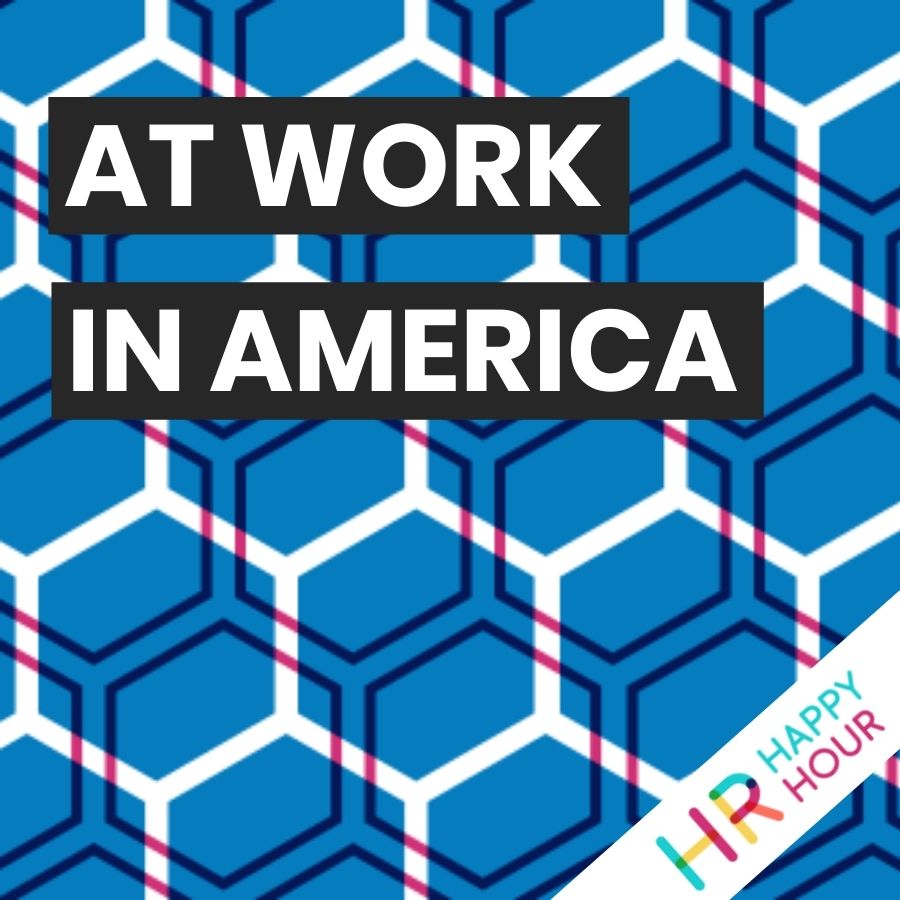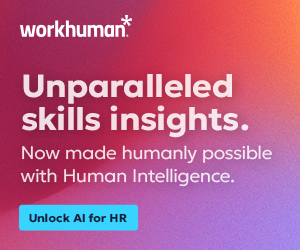HR Insights: Navigating Employee Relations, Investigations, and Technology
Hosted by

Steve Boese
Co-Founder and Chief Data Officer of H3 HR Advisors and Program Chair, HR Technology Conference

Trish Steed
Co- Founder and Chief Strategy Officer, H3 HR Advisors
About this episode
HR Insights: Navigating Employee Relations, Investigations, and Technology
Hosts: Steve Boese, Trish Steed
Guest: Deb Muller, CEO & Founder of HR Acuity
This episode of At Work in America is sponsored by Paychex, one of the leading providers of HR, payroll, retirement, and insurance solutions for businesses of all sizes. As the workplace continues to evolve, businesses are being forced to adapt and innovate to meet the challenge. Our fifth annual workforce trend study will help you understand this year’s top business challenges — and set your strategic priorities. Get the report, 2023 Priorities for Business Leaders: Trends, Insights, and Ideas for an Evolving Workplace to learn the challenges facing businesses like yours and how you don’t have to go it alone. Visit paychex.com/awia to check it out, today.
This week we met with Deb Muller from HR Acuity to talk about the importance of employee relations throughout the entire organization.
– The elevation of employee relations and what HR does on a daily basis
– Importance of doing employee investigations the “right” way
– How HR Acuity helps organizations save on litigation
– The impact of technology on HR leaders
Thank you for joining the show today! Remember to subscribe wherever you get your podcasts!
Transcript follows:
Announcer 0:00
Welcome to At Work in America sponsored by Paychex. At Work in America digs in behind the headlines and trends to the stories of real people making a difference in the world of work. And now here are your hosts Steve Boese, and Trish Steed.
Steve 0:26
Welcome back to the At Work in America show we have a great show today. Trish, we’re talking about a subject near and dear to your heart. As an HR, former recovering HR leader yourself, right? That’s one we haven’t hit on in a while. Employee Relations. That’s hardcore HR. And that’s what we’re talking about today.
Trish 0:47
Yeah, can I tell you I was thinking about this before we started recording. And I think the last time that I remember us doing a show even remotely related to this, it was years ago, and we did HR horror stories like over Halloween, do you remember that I was still working in HR. That’s how long it’s been since we’ve actually talked about employee relations, which is one of the biggest parts of every HR professionals job like that is profession.
Steve 1:13
So and I want to know, too, because I know remember the horror story shows and I remember a couple of my own personal horror stories, perhaps I told back then or could retell. But maybe we can learn about spinning this a little more positively to today, like eight like, hopefully, there’s some elements of employee relations that we’re going to talk about that aren’t all negative or punitive. And or, you know, let’s make sure we don’t get sued kind of territory. But we’ll get into that our guest is waiting in the wings. We’ll walk in here in a second.
Steve 1:41
First, I want to thank our sponsors, of course, our friends at Paychex. This episode of At work in America is sponsored by Paychex, one of the leading providers of HR, payroll, retirement and insurance solutions for businesses of all sizes. As the workplace continues to evolve, businesses are being forced to adapt and innovate to meet these challenges. Paychex fifth annual workforce trends study will help you understand this year’s top business challenges and help set your strategic priorities. You can get the report the 2023 priorities for business leaders, trends, Insights and Ideas for an evolving workplace. To learn about the challenges facing businesses like yours, and how you don’t have to go it alone. You can visit paychex.com/awia and check that out today. That’s an awesome report Trish, and I hope folks do check it out.
Trish 2:26
I love that report. I look forward to it every year. And there’s so much usable data, whether you’re a consultant or whether you’re in an HR team, or even maybe if you’re just a business professional listening. So check that out lots of good data.
Steve 2:38
Yeah, awesome. And speaking of usable data, and usable information, we’re gonna get to today’s subject matter now and welcome our guest. Our guest is Deb Muller. She’s the CEO and Founder of HR Acuity, which we’re gonna learn about here in a second. Deb, how are you today?
Deb Muller 2:54
I’m great. Trish. See. Thanks for having me. Glad to be here. I love this topic. And I’m glad you’re bringing it back up.
Steve 3:01
No, it’s great. It’s a great topic, Deb, for benefit of our listeners, maybe tell us a little bit more about yourself. And then we’ll fold right into let’s learn about a lot about HR Acuity and employee relations.
Deb Muller 3:13
Yeah, so like Trish, I’m a recovering or HR professional, I did it for I’ll say two decades and decided to go out on my own start HR committee, I realized there was this gap when it came to employee relations, people weren’t talking about it, it was sort of the back office kind of thing that you did in the shadows when your employees did something wrong. And I thought there was a way to make it more strategic, make more data oriented and drive some consistency to the process. So I decided, you know, having no technology background, that it was a good idea for me to create this product and bring it out to the tech world. And that was in Gosh, 2009 very different world than we’re in today. And HR Acuity has been going strong ever since. And Employee Relations has really changed in that time quite a lot. And we can obviously get into that a little bit more. But HR Acuity is the only technology platform that is specifically built for Employee Relations when we like to think of it from allegation through aftercare. So how people report issues, managers deal with them really before they get to HR or don’t deal with them. A big problem. Yeah, how you document things properly, if you have to conduct an investigation, really helping you on that journey to drive consistency process, transparency process for your employees. And then of course, using all that data, to power your workforce to understand what’s going on in your workforce far beyond kind of Employee Relations being more proactive. So we’re used by enterprise organizations around the country around the world and just happy to talk about this this topic.
Trish 4:48
Yeah, thank you for coming on and talking about this stuff. Because I think you’ve mentioned a couple things that I think are key. So even if you’re a listener, who’s maybe not been in HR for very long, right, this is something that we all have to kind of get thrown in to do in handle. You mentioned consistency. And I know as someone who also spent about 20 years in human resources, handling all sorts of different employee relations issues. That’s one of the biggest struggles, I think without technology. Can you talk a little bit about how that really is handled with HR Acuity? Because I think that, it’s almost like if you can get the consistency down of how you handle issues, it almost helps eliminate issues in the future. I’d love to hear your thoughts on that.
Deb Muller 5:30
Yeah, absolutely. And it’s not easy. I mean, when we think of our human resources versus our other resources and businesses, it’s not that hard to get consistency in your raw materials, right? You’re in sort of what your machinery does, and how you tweak it. You know, employees are a little more difficult. They’re diverse, they bring a lot of different things to the workplace. So if you have four people doing the same job, you’re not, you know, the consistency is more difficult. So how do we get that we have to have processes, we have to be thinking through how things go, we have to be looking at data to make sure we’re being consistent, that we might not otherwise. So the first thing we need is process and how these things are done when I was in HR, and I was doing employee relations, and it was really sort of this transactional thing, it was a someone coming to my door and you know, crying or an issue, typically, you know, on a Friday afternoon, right before my vacation, but whatever. I sort of did it my way, right? No one ever asked me my role was to sort of handle it, make it go away and make it right, you know, take whatever documentation, I have put it in my drawer, and it was never looked at sort of as the aggregate and right now we really need to think about HR and employee relations in a much more consistent way.
Deb Muller 6:47
So that we can use that data to drive our behavior. So we can use that data to be more predictive, like in finance and marketing, we’re always looking at predictive indicators of something that’s wrong, we should be doing that. And we can be doing that we’re seeing our clients doing that, by using HR data. I mean, I’ll give one example. With our manager tool, right? So man, we have a tool that helps managers document things. So when when you say to your manager, oh, you know, as an HR personnel, make sure you document that they look at you like, I don’t know, like, what what does that mean? You know, I sort of know I’m supposed to do it, I’m scared to do it. So they don’t do it very well. But if you think about all of those interactions between the manager, the room and the employee, that’s really who many employees think of as their employer. Those are sort of micro interactions. So if we think of something as as sort of ubiquitous as kind of attendance, someone’s you know, the the time and attendance warning or something like that they take an action. If we start looking at that data, we can, number one, see if they’re managing things consistently across the board, we can start looking at things like D&I, are we having more issues related to black women in the workplace? Are they getting more time and attendance warnings that in the individual we would never see? So is there something? Are we treating them differently? Or maybe there’s an issue with getting to work on time? Maybe it’s harder for them? Because they need to take care of their children, I needed to modify our policies, are we having more attrition in a certain area? Because we need more training with things? Do we have a leadership issue? So there’s so much information that can really drive how we work with our employees, and how we change the workforce, right? We do a great job of bringing people in hiring them, sometimes we’re working working on our diversity goals. And but what happens sort of between the the bookends of their experience, and that really is what Employee Relations is all about.
Steve 8:51
Deb, I love that you brought up sort of insights, right? Because one of the things I wrote down for you, you mentioned it in when you were talking was about disparate impact. I wrote that wrote that down in my notes. You think like in the old days that the first example you gave someone came into your office, and maybe you took some notes down in your notebook, and maybe they went in the drawer. And like, maybe you even handled the situation and resolved it then in there. And the organization might never know about it, right? Like you wouldn’t remember it but no insight to be gained or any ability to unveil reveal patterns or reveal, as you said, potential for disparate impact on the lineup is using the technology to support process consistency more and, you know, what’s really the value here is the process consistency, is that the reporting? Is it all of it?
Deb Muller 9:47
It’s driving efficiency is it’s, you know, it’s building transparency and trust with your employees, which I think right now, we could probably talk a whole half hour on that and how important that is, particularly in today’s environment and toward the expectations of employees, we’re starting to see that with, you know, unions and other things, players are really demanding that transparency, there’s certainly the risk part of it, right? So we live in a litigious world, as an organization, we have to make sure that we can defend our actions. I mean, you’re gonna have to terminate people we’re gonna have to take put people on performance plans and things like that. We can’t not do it. But can we define it? Can we look to make sure we’re doing the right thing? Are we treating people the same way? There’s so many opportunities to really look at that. Do we have leadership issues? Are there cultural issues happening? You know, when I think about employee relations, I always talk about this paradigm of a traffic light, right? So green light is how we want our employees to behave and what we want them to do. Right.
Deb Muller 10:48
So, we put together policies and job description and goals and things like that. That’s what we expect of someone when they come into our organization. But we know that’s just as I said before, it’s not how humans behave, right, there’s going to be the course of their life cycle, these yellow light events, where things sort of deviate from the norm. And they’re not necessarily bad things, it could be someone getting pregnant and going on maternity leave, someone could exceed their goal. But of course, there’s other things, right, they’re not appearing to see behavioral issues, just sort of interpersonal things that happen, we need to deal with those yellow light issues. And if we don’t deal with them, or we don’t look at what they might be telling us, if there’s a lot of them, then we’re going to run into the red light. And that’s when kinds of things are going with that are going to need to be investigation investigated, or there’s disparate impact, or there’s allegations, and those require a much more structured approach to how we look at that, how we manage them. And so that’s sort of where I see employee relations, we operate in those yellow light, and those red light. And hopefully, if you’re really paying attention to the yellow, you’re gonna have less red.
Trish 11:54
Yeah, I love that example. And I think that, you know, I’m sitting here shaking my head. Yes, I agree. I’m sure some of the listeners are too. Deb, one thing that Steve kind of mentioned at the top, and I’d love to hear your take on this is that, you know, sort of when you think of the word employee relations, often we think of that punitive piece of it, right. But I know a lot of what you’re talking about with this consistency and process and in everything, it really sets the tone of the culture of the workplace to potentially be extremely positive, it doesn’t have to be a negative experience, I’d love to just hear if you have an example or two, maybe, you know, whether it’s personal or maybe a client where where you’ve really seen them use that technology to take that, well, I would call more of a proactive Employee Relations approach instead of a punitive approach.
Deb Muller 12:43
You know, I think when things go wrong in the workplace, employees know things aren’t going to be perfect. But how you manage it that makes a difference. I have found in my you know, before, when I did investigations before, when I moved into this position, I found issues that were mismanage blew out of control, and you just kind of lost control of it. And I’ve seen very, pretty appalling things are taking place in the workplace, that when handled in a proper way, by management, when the employee feels like there was a process when they feel like they were listened to, they might not like the outcome, but they’re much more accepting of it. And they build trust. So for example, one of the things we have in our in our solution now and you don’t need a solution to do if you’re a large organization, you do, but we interesting, we call it an NPS survey, call it what you want. But at the end of an investigation, or even just a transaction, like an employee relations issue, you can send the employee a survey. And you’re not saying do I like the outcome? You’re asking them to sort of rate, you know, were you treated with dignity and respect? Was your issue handled in a timely manner? And how likely are you to recommend that a peer or colleague go to HR with a similar issue? And that’s that kind of that net promoter score that we do for our customers? Right? How likely are you to do that.
Deb Muller 14:03
So in the individual issue, it’s really helpful for the organization to identify an issue like someone’s not happy, you might want to get up someone more senior might want to get on the phone with them and understand what happened during the process before they go to an attorney. But in the aggregate, it does hold HR accountable to a quantifiable number of how are we doing. And we all know here that HR doesn’t always have the best reputation. I often say that it’s the most personal function that goes from job to job, no one comes to a new company and says, Oh my god, I hate finance. They were so bad at my other job. But they do that with HR, right, you know, a bad HR experience at one company and it just shades everything, unfortunately, and the only way for us to really change that is by shown like demonstrating that. So how powerful would it be for our colleague to say to somebody else, you know, I had an issue or I was a witness on a case. And you know, you actually were pretty good. Like they handled it like it, you know, I did. And that’s really how we’re going to change things and to sort of turn it to a positive. You know, HR is not always going to side with the employee than always, you know, it’s not whatever. But it’s that transparency, it’s helping people understand what the process is what to expect, you know, making them feel comfortable coming forward, if they have an issue, whether they come forward anonymously or not, that understanding how the organization is going to help them, I think really builds that trust and makes it more positive, when things are going well, or when things aren’t going well, the company has your back.
Steve 15:41
Is there elements here also of helping the organization, not just remain compliant, or adhere to predefined processes, but also sort of get better at this? Like, if I were new to HR, for example, or, you know, just starting my career, I may not know all the right steps or the required steps are the best way to address many of these employee relations issues, because especially a smaller company may be right. It’s it’s one of many things I’m doing right. It’s part of my role. Is there an elements that that a more structured process or software, empower powered process can help me just do better at it and get better at it?
Deb Muller 16:20
Yeah, absolutely. Particularly, I’ll point to the investigation process. Our step by step process is I would say it’s flexible, but it keeps the integrity of the process, right. So you can’t have a, you know, investigation, do step one, step two, step three, that doesn’t work because no situation like any others, but I heard someone on my team describe it as sort of like bowling with the bumpers, right? You’re still like going down the path, but it’s sort of keeping you within the lane. So we do things like we have a process where it really you’d have to do this for all of the smaller investigations. But it helps you really think about what am I investigating? What are the unknowns? What are the things that I need to get to the bottom of so it gives me the scope of my investigation, which is going to drive who are the people I need to speak to what documents do I need to get so you you go abroad when you need to keep it narrow, when that’s also appropriate. Our interview guides are built in with protocols for the company to kind of set that make sure you remind them about the non retaliation policy that drives consistency, it builds trust for the person you’re talking to. Also the collaboration that’s allowed so that if you are more junior, your leader can help you set up the interview guide, think about you know, the documents, you can work together on it and really collaborate even with legal when you need to. So that helps tremendously.
Trish 17:45
I love that idea of kind of a guardrail or like the, the bumpers on bowling, because I think as a new HR professional, you are relying on your manager or your director or your CHRO, whatever the case might be to be that person to kind of take you down the path and teach you how to do this. And you’re right, we all handle it a little bit differently, some better than others, right. But there are always those times whether I’ve been in highly professional jobs, or manufacturing jobs from doing HR or health care. There were always those instances when I was very junior, where my boss wasn’t around, and something was blowing up in the moment right? How nice it would have been to have, whether it’s a checklist, or just a process that I could even loosely follow and feel like I am staying within sort of legal best practices for my organization, but also for the employee. And I’d love to hear you kind of talk a little bit about kind of that maybe miss conception that some employees feel like HR is always there just for the the employer, right to protect the employer. I think over time, I learned that we’re actually there to also be advocates for the employee and make sure they’re legally protected. Can you talk a little bit about how do how do those kind of guardrails help in that aspect to for employees?
Deb Muller 19:05
Absolutely. I’ll say as an experienced investigator, look, I know investigators are waiting, I almost I want those as well. Because whatever happens, that investigation is going to impact someone’s life. Like you have to no matter where you are. It’s just good to know you something to lean back on. I think you’re right, we have to change sort of how we’re doing things. And we have we’ve built this employee relations community, both with clients and not with employee relations leaders. And really we talk about that a lot. How do these sort of change the the misconceptions or the whatever the perceptions, whatever they are, of what happens and build that trust. And we’re seeing a couple of really innovative things that I love, and we’re really kind of pushing people so we have a client that we have a client, not a lot of people do this and we’re starting to see it. They publish out the data, right so they publish out to combine how many issues they’ve had that quarter? I think they do On the corrective actions that they’ve taken, some of our clients I’ve heard, like substantiation rates, but even that can be a little bit, miss a bit of a misnomer because sometimes something’s not substantiated, but you still do something. And that builds trust, right? Because you’re immediately saying they put it on their website on a compliance website, you’re immediately saying to your employees, we’re counting just the fact that you’re counting says there’s a process. And guess what, in all these cases, we actually are taking action. So I think that starts to sort of trauma tables.
Deb Muller 20:31
Another thing another one of our clients does, which I when they told me this, we were firstly bringing them on. And now we’re actually starting to think about kind of embedding from a technology standpoint, is around retaliation. So this is what I love. We all have, we all know about non retaliation policies, we’re not allowed to retaliate. So how do we use them that we say to an employee who’s come forward to tell us about something terrible that they believe is happening to them? That’s really hard. Number one, you know, that’s tough. And then when we sit down with them, we say, Thank you for coming. And we have a non retaliation policy. So if you feel you’ve been retaliated, let us know. So you’re basically saying one bad thing happened to you, it took courage for you to come forward. Now, if another bad thing happens to you, you need to come forward again, company is doing is when when an employee comes forward, they’re tracking that but putting it like a retaliation flag. And behind the scenes, they’re looking at compensation decisions, or looking at performance management. And they’re seeing, they see signs that that employee is being retaliated against, the employee might not even know and then they’re taking action on it. And that is innovative. That is putting your arms around your employees because you want them to be in the best position to do their best work. Right. And to you know, have that safe environment.
Deb Muller 21:43
So I think those are, you know, things I love, you know, one of our product, wrote what’s on our product roadmap this year is really thinking about more about that aftercare. Right? How did we and where I started with the technology, just looking at it investigations and then sort of broadened out to er, sort of documentation. We really now look at our our platform. As I said before, from allegation to aftercare, the investigation is just a piece of it. By the time it gets to an investigation, something’s gone wrong, your employees been harmed, whatever, how do we look at it from the very beginning, look at the data all the way through aftercare and sort of continue that on. So did we make things better? Did we help the employee? are we checking in to make sure the remediation was actually worked? We can do great investigation, but we don’t stop the behaviors doesn’t matter? Are we learning from it? Is there something as organization where there was a weakness or an opportunity for us to get better? So that’s sort of the I mean, if you think about employee relations, that’s, you know, between those bookends, right, everything that happens during an employee’s lifecycle.
Trish 22:47
I love that because that, Steve, that gets back to what you were asking about, you know, does it help the organization and leaders get better? So yeah, knowing your data, right. Would would do that? I think?
Steve 22:59
And I love this idea too Deb, you kind of alluded to supply chain, and process and inventory and things like that, right, where organizations typically have a really good handle on right, a lot of sophisticated technologies behind Supply Chain Management, or finance or what the case may be. And I think about all the different systems we’ve seen over the years, that, you know, these fancy dashboards, that that someone who’s doing a process manufacturing with the Oh, Red Flag Warning, you know, component ABC is low, you’ve got to figure out how to get some more and then the system being smart enough to immediately talk to purchasing gets the purchase order queued up just waiting for someone to hit the hit the checkbox, and then that part is replenished, right? It just happens, right? And there’s lots of examples of that. But there’s not really right, we don’t have that, and a lot of really important people related processes, right. So for the example could be one, one area, one region, one manager, or everybody who rolls up to a certain DP is experiencing more of these types of issues involving ABC issue, and why is that happening? And surfacing that? I guess so I guess was what I’d say to have the ability to surface that much before it so that anecdotally it surfaces up and all of a sudden, you’ve got a crisis?
Deb Muller 24:15
Exactly. So we have in HR Acuity, you can sort of see just in time data, you know, for the individuals that are involved, you know what their history is, but also sort of within that location, or that group or functional area, what’s going on, we’re actually totally redoing our reporting and analytics this year, which is pretty exciting. But the whole idea is to deliver those stories so that the HR business partner or the ER partner can go to their business leaders and ask questions, you know, gee, you had this many more cases than similar people like what’s going on? Is there a leader issue or be flagged to say, Gee, somebody has hit a threshold? Let’s go check and see what’s going on there, which is really important. We’re also looking at things like complexity, you know, is every case equal to every other case? They’re not so how do we start to look at you know, weird things Look more complex or more risky to start to look at them ahead of time and get ahead of that we have we look at events. So a little bit historical, but are there events? And don’t do that? Do they trigger certain things.
Deb Muller 25:13
So in HR, you know, you always sort of say, well, my guts telling me that, you know, we had more issues for the holiday party or whatever, well, this helps you drive the data, so then you can eat it, let’s say the holiday party is a great example. So we have the holiday party, we spiked up in cases. So then his organization, you could say, well, next year, we better just get more people ready to handle them, where you can start looking at them and saying, gee, are there are ways that we can start making our employees safe, and really get ready for next year, so that we can actually bring that down and provide a better environment? Or, you know, even measuring? Training, right? We know, if there’s sexual harassment training, we’re going to see an increase in in allegations. That’s actually good, right? That means people have listened. So different ways to really look at it and sort of correlate the the data, that some of which we’re already doing different alerts that come out in the system. And we’re really looking at the next gen. Now, how do you kind of continue to do that? How do you bring additional data from the organization into to, to integrate it as well?
Trish 26:13
I love that. You’re also taking some of those examples, how you talked about your current clients who might be innovating without technology, and then you’re sort of putting that into the technology? Because I think it’s like, if people were seeing this have to be shaking their heads in agreement with a lot of this information, right? Because we all struggle with the same things. People are not that unique in that job, job, it doesn’t matter. I have been in, like I said, the most professional work settings, and some that you would think were not. And sometimes it’s one of the professional settings where things are far worse, right? There are far more issues. You said earlier, terrible things happen. I do kind of like the idea of being able to let the wider population know because typically, those things are kind of hush hush, and only a few people know. Now, of course, you can’t share details. But I would love for my colleagues to understand like we do have issues here and we handle them, it is not going to be tolerated. It also kind of sends that message like, Look, if you do certain things you will not be working here where I think in the past, you know, if you think of probably any job you’ve ever had, right? There’s always that person that’s been there 20 years bad employee, I’m doing the air quotes. No one can get rid of them? Well, it’s because over time, the HR leadership changes or their manager changes.
Trish 27:30
And there’s nowhere that it’s ever tracked, that that person has had issue after issue after issue this would like, I can literally think of at least 10 people in my career where that would have corrected that problem, just by having this technology in place. Because that way, if I’m the HR leader, and I leave for a new job, if that hiring manager, that manager leaves for new job, it’s still there, it’s still actually correct, you know, correctable and actually, you can save people I think I wrote down earlier, when you’re talking corrective actions are actually meant to help the employee get better. They are not meant we use them often to like reprimand someone, right? Punitive again, but really a true corrective action is meant to help you it’s just to make you aware of what the expectations are, and how to improve that. And you will find, I don’t know, I’d love to hear what you think about this, like, have you had employees in your past or whatever, like, because you didn’t have the solution? Where had you known they were going through a divorce had you known they were ill or had a sick family where like, maybe performance has slipped, or their attitude has slipped for a really good reason. We had no, we had that happen. I mean, I feel like this would solve for that too.
Deb Muller 28:49
Of course, but that goes back to the manager. So actually, our product that focuses on the manager is called Manage or like manage ER, we were very excited.
Trish 28:59
Oh, I love that.
Deb Muller 29:02
Yeah. So but you know, that is, you know, we need to help empower our managers to sort of know how to have those conversations know how to ask that. It’s very in a you’re tethered to HR in it. So we’re not letting them on their own, they can always kind of go to HR and get additional help or HR will help them through those things. But absolutely, particularly now, I mean, I think if we’ve learned anything, since COVID, and everything, you know, mental health issues, people working from home, I mean, there’s just the whole opportunity to really help our managers into the workforce when you’re not seeing somebody every day you don’t know what’s going on and making sure they’re asking the questions. I don’t know. I mean, the system helps with that a little bit. I’m not going to tell you it like kind of right now at least for pings you and asked you that things, but just giving them the tools and documenting and making people you know, put it in a system someone actually said to me once Oh, I get really nervous, you know that my managers have been having put something in the system. I’m like, Well, if the They’re not doing that. And they’re either not doing it, or they’re putting it somewhere that you don’t even know what they’ve written down. So that’s just as vulnerable. And as risky. You don’t have the information to do anything, if there’s something going on in the aggregate. So let’s teach them let’s be, you know, help them do this. And I do think that people have told me that you’re putting something in the system, you’re more thoughtful of what you’re writing, as opposed to in your your notebook. Because you there is that element of, gee, this is discoverable. I even think I’ve seen and heard that investigations are better documented, right?
Deb Muller 30:34
We have a lot of investigators, I can have a hole, you know, the the amount of training that gets done for investigators is not high enough. We just did our benchmark study, which I can share, you know, we do every year, and I just saw the results have come out in June, the amount of training that goes for investigators is low. And so if you are doing your investigation and putting your notes and your findings and a report, if you do want to in your drawer, you’re probably going to be okay until there’s some litigation, and then the company screwed, right? If we make them go through this, you’d have to, you know, you can, as a leader, you can start looking, you can start auditing, not necessarily for the issue, but for quality, do training gaps are the people that shouldn’t be investigating. It just all of that is going to it’s going to have a positive impact for the organization, but it’s going to have a positive impact for the employees as well, because they’re going to have been going through a compliant investigation. Yeah, that’s wonderful.
Steve 31:30
Yeah, this is really interesting. Because for me spending a lot of time in the technology space, I sometimes think about, well, where where’s the incremental value going to be created from technology, right, in sort of our people functions? Because I think sometimes, right? Everybody’s got a payroll system. They generally all work fine, right? Everybody’s got a benefits admin system, they generally all work kind of the same. They’re all fine, right? For the most part, like finding ways to actually move the needle on employee experience on outcomes, even on compliance. Like, it’s sometimes it’s in these areas, right, like, you know, thinking, Okay, let’s think about standardizing process, defining process, getting data rich insights from our Employee Relations process, there’s an area where many organizations could probably tap into to say, where can we drive more value? By smart application of some new tools and some new processes? Deb, you’re nodding your head, I think I’m guessing your clients are seeing this right, who decided, hey, let’s do this. And maybe last thing for me that I guess, Deb, I’ll ask you that and this way, maybe share again, anonymized right, you don’t have to call names, couple of the outcomes you find in for organizations to adopt these tools, and then it’s kind of standardized process a little bit and and then get the get the get the data insights that we’re talking about? What are some of the things that happen? Well, they can actually report right?
Deb Muller 32:48
Many companies are coming from nothing, or spreadsheets, right? Or we see companies that are sort of forced to jury rig from like a standard case management system. This is not a ticketing system, like you can’t take it your way through employee relations, right. But you can because of the nuances. So I think the most power is when it’s integrated with that. I love the analogy that I use about, about the analogy I use, but whatever, it’s a good analogy. But you think about employee relations to the employees, to my from my perspective, I the heart of your organization code fits even better there. So employee relations, and how you manage it is sort of like a heart surgeon, right? You’re doing something pretty bespoke, it’s everybody, every case is going to be a little bit different. But you have to have certain skills to do it. So if companies use sort of a spreadsheet or a ticketing system, that’s like going to your general practitioner and saying, Hey, can you do my heart surgery for you? You know, or let me tell you how I’m doing it. And having this sort of conversation with, you know, your general practitioner about how you went to the party, sometimes you need this specialized software. And I know that, you know, a lot of companies will say we want as few pieces of software as possible. In this case, you don’t, it’s really important that it’s handled differently, that it’s nuanced. We build into our system, those nuances to help you with it, because we understand employee relations, we’ve done it in ways that you know, an engineer cannot will probably not be able to do it. And I think that’s the value. We’re not asking you to give up sort of ticketing and things like that.
Deb Muller 34:25
We’re just asking you to look at it differently. So you really get a handle. I know my customers are now delivering dashboards, to the boards, to their business leaders. They’re having conversations, they’re identifying training needs, many of them have identified for the for their own selves, staffing requirements, and they’ve actually been able to get additional staff because they can now show the work that they’re doing and the impact on it, and the ROI on it. So it’s it’s really wonderful to see and I mean, Trish, you mentioned before about sort of listening to our customers. I love that right? I recognize I have not I’ve been in the HR world now for several years that we’ve had the company. So when we talk to our customers, we talk to our community, these tell us about these things, you know, the hair on the back of my arm, so stands up, because I’m like, Oh, my God, oh my god, we can we can help we can help with this with and can really leverage technology.
Trish 35:16
Yeah, I love that you shared too, that you can take this information to your other leaders who are not in human resources or your board because they’ve never done this job. It’s one of those parts of HR that really a lot of people in the organization majority do not see. And so you know, when it comes to hiring, yes, the senior leadership absolutely can understand hiring when it comes to firing, they can understand that, but it’s that in between area, that, you know, this is also like the heart analogy, because it’s when I think of all it some of the big ones in my career. These are such personal matters, personal attacks on people, physically, mentally, emotionally, whatever. And we’re not therapists, we’re not trained to, you know, to do this, but yet we do this work. And so understanding that as an HR professional, there were many nights where I would go home and feel just completely exhausted mentally and physically and emotionally. If I had a way to kind of consistently handle things with my, both of the ones I handled on my team, I think that might have also, which we didn’t really talk about, but like alleviated some of that stress that your HR leaders face, because we are like islands out there, we’re doing this work kind of in the dark corners of the company. And so I just want to say thank you, first of all, for creating something that will help truly help HR. We’ve talked a lot about how to help somebody else. Maybe my final question to you is just can you talk just a second about kind of the impact that this could have on your HR team and how their mental health and their satisfaction in the organization could be benefiting?
Deb Muller 37:02
Yeah, well, it’s going to help them become more strategic. I mean, there has been such an elevation of employee relations in the last 15 years, I did this whole timeline of sort of what happened in my career from the late 80s. Till you know, 2015, and not a lot happened. And then we had in the impeachment movement, we had black lives matter, we had. So much has happened, that it really elevated this conversation out of HR and into the C suite and into the board, there’s no personal liability that the leaders have to talk about. COVID really was the time for ER had to step up in ways that they had no understanding how to navigate it, and are so proud of the work that all of our colleagues in the community did during that time. So it has given them using this data and having technology has really helped enable them to provide that strategic insight to their leaders in ways that they couldn’t, there’s always going to be a transactional portion of it and sort of that unpredictability. But we’re starting to build that data so that they can have those more strategic and forward looking conversations about how what they do and what the other leaders in the organization do to affect the employee experience, which is, you know, at the heart of the organization.
Trish 38:15
Yeah. And these are some of the the most sensitive employee experiences that that are had in an organization. So how you handle them with that dignity with that respect, is absolutely key, whether you retain that employee or not. That’s like so important, right?
Steve 38:33
Yeah. And for sure, the last thing I’ll add is like, and I don’t want to manage these the same way I manage like putting in a request for like a new laptop keyboard or something like that, right. Like, it sort of makes a lot of sense to me, Deb, the way you explain it. Like, yeah, there are great systems out there to manage tickets to manage workflows, manage cases, and integrate with them. Honestly, most of most large organizations have to have those for a myriad of reasons. But yeah, they’re never I’ve seen a lot of those over the years, right? They’re never set up to handle things like this, like the, the sensitive nature of this. It’s very specific nature of these. And the importance, quite frankly, of them. Because whether or not I get my laptop keyboard on time doesn’t really matter in the grand scheme of things, right. It’s not the end of the world. But these things are very, very important to both people and to the organization. So this was really fun. Deb, thank you for joining us today. For folks who want to learn more and maybe connect with you and HR Acuity, where would we like them to go?
Deb Muller 39:34
So obviously, we’ve got hracuity.com. I do want to point out that just recently, we launched something called the ERQ, which is the first employee relations maturity model. So all the other functions have maturity models it was time is if you go onto our website, you can actually take a short quiz to see where you are and the maturity model will give you some tips and hints as to you know, how to move from one step to the other. So when you use our software or not, it’s just a good I think it talks about technology and resources, all the things to kind of determine where you are on that spectrum. So but I’d love to link in with anybody obviously can find me on LinkedIn. And if you want more information about the solution or demo reach out to me or on an online you can request to download we’d love to I always just like to get people’s take will take out of curiosity, you know, one of the challenges that people haven’t seen this before, right they’re seeing so just be curious. Let us show you what it can do. And then you figure out if it’s the right thing for your organization.
Trish 40:31
I love that, the curiosity tour.
Steve 40:38
We’ll put some links in the show notes for that and we want to thank Deb Muller from HR Acuity, CEO and founder for taking some time with us today. It’s been great I encourage folks to check out HR Acuity out what they’re doing and yeah, improve the way you’re handling these most important issues in the organization. That’s that’s certainly a good thing. So Trish good stuff. I love it. I know you love this topic. This is right in your HR wheelhouse.
Trish 41:02
I do it’s so hard not to want to just like talk to them for like the next three hours because I think you know, again, it’s it is like a support group, right? You sort of have been through and I really believe that most employees don’t even know how bad things can get in an organization and I think that’s a testament to good HR, you know, handling such a wide variety of things.
Steve 41:27
We’ll save those stories for another show. I know we need to do way too long for that again, maybe we’ll bring that back this Halloween. So okay. Thanks to our friends at Paychex of course for all their their help and support many years and we love them. Thanks to Deb at HR Acuity. Trish, thanks to you. Check out everything going on in the network HRHappyHour.net. The shows are coming fast and furious – Inclusion Crusade, Play by Play, HR Means Business, all of it on HRHappyHour.net. Thanks again for listening. We will see you next time and bye for now.
Transcribed by https://otter.ai
Talk to us
If you want to know more about any aspect of HR Happy Hour Media Network, or if you want to find out more about a show topic, then get in touch.









